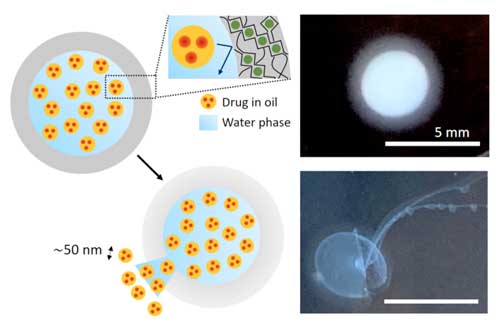Nanoemulsions in Pharma, Cosmetics, and Food
Definition: Nanoemulsion is a tiny, mixed blend of two liquids that usually don't mix, like oil and water. These blends are incredibly small, measured in nanometers (one billionth of a meter), and stay mixed for a long time without separating.

What is a Nanoemulsion?
A nanoemulsion is like a tiny cocktail of oil and water, mixed so well that the droplets of oil or water become incredibly small, almost invisible. These droplets are stabilized by special ingredients called surfactants, which help keep the mix stable and prevent the oil and water from separating.
How Are Nanoemulsions Made?
Creating nanoemulsions usually involves using high-tech equipment that shakes or stirs the mixture vigorously. This breaks down the droplets to a nanometer scale, resulting in a stable and smooth blend.
Where You Find Nanoemulsions
Nanoemulsions are popular in making medicines, beauty products, and even food items. They help in delivering active ingredients effectively, like ensuring medicine is absorbed better by the body or making cosmetics penetrate the skin more efficiently.
- Medicine Delivery: Nanoemulsions can carry and deliver drugs more effectively, often reducing side effects.
- Beauty Products: They allow creams and lotions to feel smoother and help the skin absorb them better.
- Food Enhancements: In food, nanoemulsions can encapsulate flavors or vitamins, making them more effective and tasty.
Benefits of Nanoemulsions
The tiny size of the droplets in nanoemulsions makes them special. They are very stable, meaning they don’t easily separate, and they can deliver ingredients more effectively than larger-sized emulsions.
- Long-lasting Stability: Because of their small size, these emulsions don’t separate easily, making products last longer.
- Better Delivery of Ingredients: Their tiny droplets mean ingredients are absorbed better, whether in the body, on the skin, or in the stomach.
- Improved Look and Feel: In cosmetics, these emulsions are clear and less greasy, making them more appealing to use.
Challenges with Nanoemulsions
Although beneficial, nanoemulsions are not without challenges. They can be expensive to make and might change under different temperatures or conditions.
- Cost of Production: The equipment and process to create nanoemulsions can be costly.
- Sensitivity to Conditions: Changes in temperature or environment can sometimes affect their stability.
The Future of Nanoemulsions
Researchers are constantly working to make nanoemulsions more effective and environmentally friendly. They are exploring ways to make them with less energy and more natural ingredients.
As technology advances, we might see even more innovative uses for nanoemulsions, especially in delivering drugs more efficiently and making foods healthier.
Eco-friendly Approaches
Creating eco-friendly nanoemulsions is becoming more important, focusing on using natural materials and reducing energy use in their production.
Expanding Applications
The potential of nanoemulsions in various fields, like targeted medicine delivery and sustainable food production, is vast and exciting.
This guide provides an easy-to-understand overview of nanoemulsions, their formation, uses, and potential, making it a handy reference for anyone interested in how small-scale technologies are improving our everyday products.
Further Reading
Environmental Chemistry Letters, Nanoemulsions for health, food, and cosmetics: a review
